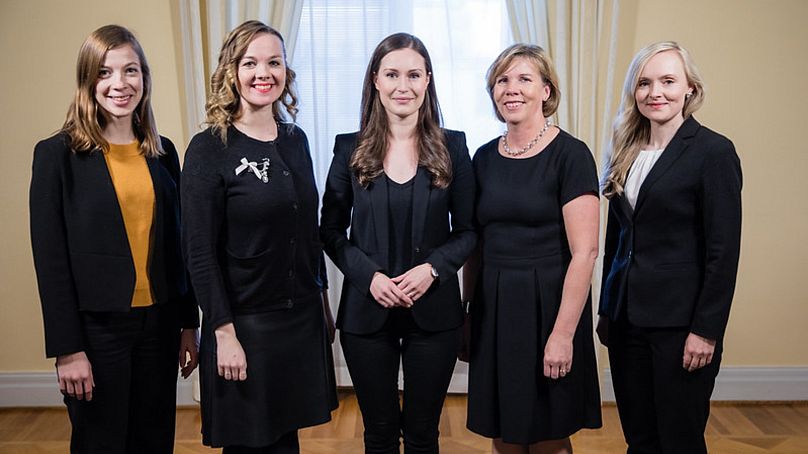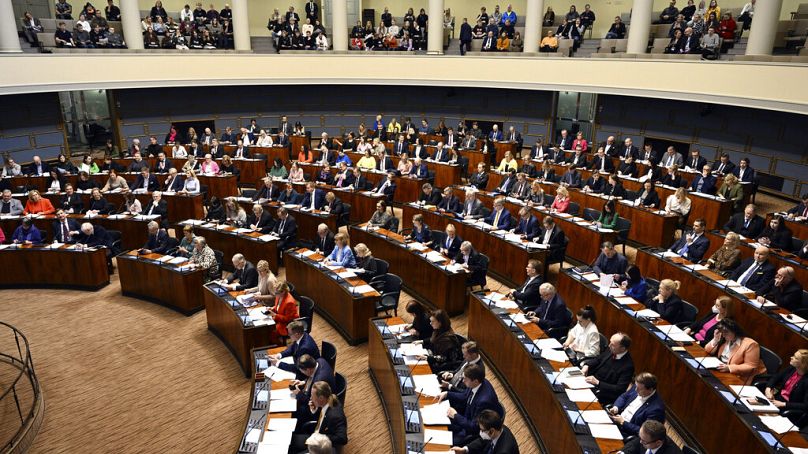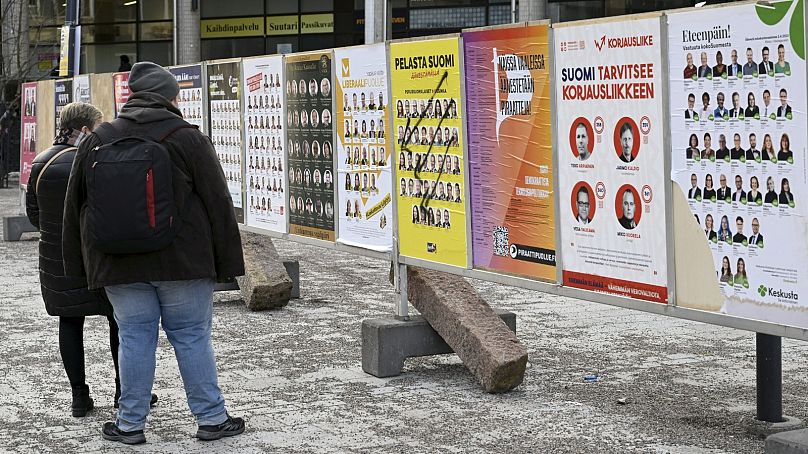Here's your quick and easy guide to the politics, parties, personalities and the issues at stake as the Nordic nation votes on 2 April.
Voters in Finland go to the polls on Sunday in a general election that could see a change of both prime minister and the ruling coalition government.
Here's everything you need to know about Finnish politics, parties, personalities and the issues at stake as the Nordic nation votes:
How did we get here?
The last general election in April 2019 saw Prime Minister Antti Rinne brought to power, leading a new red-green administration.
If you don't remember Rinne, that's because he lasted less than six months in office and was replaced by Sanna Marin before the end of that year, after some internal squabbles with the Centre Party.
A Centre Party leadership change resulted in that famous female-led government lineup in Finland -- where all five party leaders were women, with four of them under the age of 35 at the time -- something which put intersectional feminism at the heart of government policymaking.
There was yet another change of leader at the Centre Party in 2020, but it still left five women heading the government -- unprecedented in Finland or anywhere around the world.
How does an election in Finland work?
Up for grabs on 2 April are 200 seats in the Finnish Parliament -- or Eduskunta -- including one representative from the autonomous Åland Islands (which also has its own small parliament in the capital Mariehamn, to govern on devolved issues).
Early voting already got underway from 22 to 28 March at locations around the country (and from 22 to 25 March at Finnish embassies. According to the Ministry of Justice's election information service, by Monday morning some 25.9% of people had cast their ballots ahead of Sunday's election day.
Unlike some other Nordic and Baltic countries, there's no minimum threshold for parties to get into parliament, but if a party gets more than 2% of votes nationally they qualify for state funding in the future.
Which are the main parties?
At the last election in 2019, there were nine parties returned to parliament, spanning from the Left Alliance on one side of the political spectrum, to the far-right populist Finns Party on the other.
There's been a bit of splintering in parliament since then -- one Finns Party MP was expelled after being too racist, and set up his own solo parliamentary group.
Meanwhile, a National Coalition Party MP lost the support of his party's leadership after allegations surfaced about his conduct with young women, and he also flew solo (he's since decided to stand as a Finns Party candidate in April's election).
There was very little to separate the top three parties in 2019 -- Social Democrats, Finns Party and National Coalition Party -- with just one seat between each of them, and the polling is equally close at this election too.
Social Democrats: This is the ruling centre-left party headed by Sanna Marin. Traditionally pro-union, more recently a political home for immigrants and people with a foreign background, Marin has positioned the party as more progressive and pro-European than ever before. A criticism however has been that she does not have a wide circle of political advisers, can tend to take decisions on her own, and it has been reported there's nobody around her to say "no" -- even when needed.
National Coalition Party: A right-wing, conservative political party headed by Petteri Orpo, and part of the EPP on a European level. Orpo's not the most charismatic leader and has historically struggled in debates with other more competent party leaders. The National Coalition Party, or Kokoomus as it's known in Finland, is the only mainstream Finnish party never to have a female leader.
Finns Party: A far-right populist movement, the Finns Party has done well to position itself as a place where protest voters can find a home: even as topics on which they traditionally focus like immigration, have become less of an issue during this election campaign. The party's leader Riikka Purra can come across as dour: but her plain style of speaking, and the party's increasing use of TikTok, has seen them really connect with younger voters in particular. However, there are still a lot of issues along the way, with allegations of racism in this campaign, and a number of Finns Party MPs with court convictions for race-related charges.
Centre Party: Keskusta was a powerhouse of Finnish politics for decades, and even two governments ago was the largest party in parliament, when Juha Sipilä was prime minister. After a terrible election result in 2019 when voters punished them for their part in austerity policies, Keskusta is on its third leader in Annika Saarikko who has marched her party down to its lowest ever polling numbers ever. Keskusta is an old agrarian party and still gets most of its support from rural areas. If they do as badly as predicted at this election, losing 5-10 seats, Saarikko's time in office could be measured in minutes rather than hours: but you can never count Keskusta out in Finnish politics.
Green League: Finland's Greens have also been having a rough time in this election campaign, and in Helsinki we could see their dominant position slip, as they lose voters to the Social Democrats. They're very much an urban Green party, like many in Europe. Their leader Maria Ohisalo is a talented politician, but has been under-used in the current government as interior minister where she had less chance to shine.
Left Alliance: Under the leadership of Li Andersson, one of the sharpest politicians in government, the Left Alliance have had a good four years, and are on target to pick up a few extra seats at this election.
Swedish Peoples' Party: The Swedish People's Party are one of the constants of Finnish politics, easily able to adapt themselves across the political aisle. They have been part of almost every government since the early 1980s. Their conservative economic policies fit nicely with the right, while their socially liberal, pro-European and values-based politics fit easily with the left. After seven years as party leader, we could however see Anna-Maja Henriksson step down, but expect the election result to be stable nonetheless, with 10 MPs predicted.
Christian Democrats: While the party has drifted further to the right over the last few years, and lost support, its leader (former world champion long-distance walker) Sari Essayah is well-liked and widely respected in parliament which possibly opens doors to government, when coalition building begins.
Liike Nyt: The 'Movement Now' party was founded by millionaire businessman Hjallis Harkimo who has been compared to Donald Trump as the former host of the Finnish "Apprentice" TV show. He appears to be trying to create a political dynasty with both his son and niece running for parliament in next Sunday's vote. Liike Nyt are unlikely to get more than one MP - Harkimon himself - into parliament as they bank on his own personal popularity especially among the small business community. A party which started out as an interesting experiment in democracy -- Likke Nyt originally wanted to take positions on issues in parliament based on what their members voted in online polls -- has largely just become a vanity project for Harkimo.
There are also a dozen or so other, smaller parties fielding candidates for the election. A number of them are on the extreme far-right -- basically neo-Nazi and white power parties -- as well as the Feminist Party, an animal rights party and the Liberal Party. The Liberals (which started out life as the Whisky Party!) have been gaining ground for a few years, particularly around the Helsinki capital city region. Although it still seems like a reach for them to get a candidate elected to parliament, they might just cross the 2% threshold to receive state funding for their party going forward.
Main policy themes
This is an unprecedented election in many ways: Sanna Marin's government lead the country through the COVID pandemic, to general (if often grudging) satisfaction at home (but a fair amount of international praise).
Marin also goes down in history as the prime minister who launched her country's NATO application process.
Previously, Finland had been closely aligned militarily with NATO and the West but was not actually a member of the military alliance. That all changed in early spring 2022 after the Russian invasion of Ukraine, when Finnish public opinion swung suddenly in favour of joining NATO.
Marin is credited with not only taking Finland down the path of NATO membership but with pulling Sweden in the same direction: and it looks as if she might still be PM if both holdouts, Hungary and Turkey, ratify within the next several weeks.
During the last election campaign, values issues like the environment, immigration and equality were important themes. However this year there has been much more emphasis on the economy, the cost of living crisis, and spending priorities for whoever gets into government.
"In the end, everything boils down to money one way or another. Whether we are talking about social politics, or education or national debt, I think everything is about money," says Jenny Kärimäki, a political history researcher at the University of Helsinki.
"Of course, it's all about where the money goes, and that's an ideological choice, so we are back to discussing these very very traditional left-right issues," she tells Euronews.
One important factor in this election is Sanna Marin herself, explains Kärimäki, as the PM continues to perform strongly in the polls -- better than her party, and better when measured against other party leaders.
"If you look at opinion polls when people are asked whether they think Sanna Marin has done a good job, then her rating is always significantly higher than the rating for the Social Democratic Party. So she is definitely an asset to them. Then again, one can only vote for her in one electoral district," says Kärimäki.
"Then again, Sanna Marin as a figure, although she has a lot of support across party lines, there are also people who dislike her very intensely."
Any political blunders along the way?
No election campaign - indeed, no parliamentary cycle - is complete without some blunders along the way, and Sanna Marin in particular is no stranger to apologising for things that went wrong.
In December 2021 she had to apologise for going on a night out to a Helsinki bar after the foreign minister got a positive COVID result. In summer 2022, she again felt she needed to apologise after videos of her dancing with friends, and dancing closely with a man in a nightclub went viral. She submitted to a drugs test (which also came back negative) and apologised yet again after two of her friends posted topless pictures in the official residence.
She was also forced to apologise after a Euronews investigation found that little or no work had been done to advance a new piece of legislation on rights for Finland's indigenous Sámi people, something which Marin had promised to get done. The bill ultimately failed at the last parliamentary committee hurdle.
None of this seems to have done her any harm in terms of domestic support, but critics have been harsh on her over more serious policy issues after she recently said during a visit to Kyiv that Finland "could" have a discussion about sending ageing Hornet fighter jets to Ukraine.
After some Ukrainian media outlets latched onto this vague answer as if Marin had made a solemn promise, her political opponents at home have been trying to frame her as naive, ignorant or reckless not to have given a more concrete answer, that the Hornets were needed in Finland.
Finland's leading newspaper Helsingin Sanomat says the issue might even cost Marin the election.
Meanwhile, none of the main party leaders covered themselves with glory at a recent television debate which descended into finger-pointing and shouting -- something decried in the papers as uncivilised and somehow deeply "un-Finnish" as this short clip demonstrates:
The National Coalition Party is not without its policy problems as well. Long seen as the party of the comfortably well-heeled in Finland, they've recently had to flip-flop on cuts to student funding and backtrack on other budget issues like how to balance the books and reduce national debt.
And the Finns Party caused a collective national gasp of horror recently when leader Riikka Purra said culture was a "luxury" item - a hard sell in a country which revels in its rich literary, musical and visual arts scene: from small-town libraries to big international festivals and all points in between.
When can we expect some results - and who might win?
We should know, more or less, the results of the election by midnight Helsinki time on Sunday evening.
But that's when the horse-trading really starts.
Some polling has suggested the Finns Party could win up to 49 seats, ahead of Kokoomus and the Social Democrats, tied in second place.
If that is the case we could see a far-right lead government for the first time in Finland, a so-called black-blue government with the Finns Party, National Coalition Party, Christian Democrats and possibly Liike Nyt.
"Some parties have now declared who they will not go into government with, but nobody has made the same kind of declarations about who they will go into government with," explains the University of Helsinki's Jenni Kärimäki.
"The Social Democrats, Greens, Left Alliance and Swedish People's Party have declared they won't go into government with the Finns Party. But then the Centre Party says it won join any government that looks like the current government," she adds.
If other parties don't want to govern with the Finns Party -- or if the National Coalition Party or Social Democrats find themselves in the lead even by a narrow majority -- we could see a blue-red coalition instead, including the Swedish People's Party and either Greens or Left Alliance.
In case that alliance would be too left-leaning to be palatable for Kokoomus politicians and voters, the Christian Democrats under leader Sari Essayah could find themselves with a token one minister to balance the scales.
Or there could be another broad-spectrum government, with Finns no strangers to so-called rainbow coalitions.
"If we assume that Keskusta doesn't go into government, then all we have left is a rainbow coalition. We are currently running out of options and combinations, and a rainbow coalition seems like that's the way things are going," says Jenni Kärimäki.















